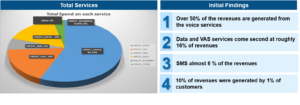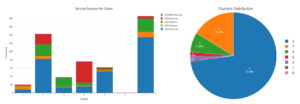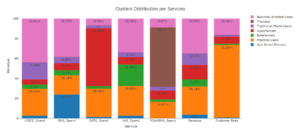
25
Jul
Recognizing the Potential
Our telecom client is an Asian-based and the second largest player in the country with a 30 per cent market share and a post-paid to prepaid user ratio of 10 to 90. Despite the growth in the Asian mobile market, our telecom client was facing a large decline in revenue and ARPU over the last 5 years, especially with about seven telecom operators competing locally. In a market where mobile penetration is 56% and over 52 Million of unique subscribers, the client realized that there’s a plenty of room for growth if clear understanding of customer needs and preferences is achieved through machine learning and advanced analytics.
Reading Customers Minds
Working with the client, Cognitro acquired 1 year of the client subscribers data which included demographics, CDR (Call Details Records), customer spends across services (Voice, SMS, Data, VAS, and Roaming ), sampled at a daily level for about 250,000 customers. The client operator was interested in multiple insights that could result in improved customer spend, improved marketing effectiveness and ROI to maximize share of wallets as well creating targeted offers aligned with consumers needs. Preliminary analysis first revealed a first glance at the operator business and customers.

Four segmentation schemes are considered: Customer Value Segmentation, Customer Behavior Segmentation, Customer Life cycle Segmentation and Customer Migration Segmentation. Looking at examples of how each of the above tends to be used, it was concluded that advanced use of segmentation allows each customer to be part of a micro-segment, which allows for precise targeting, with knowledge of what the retention and value drivers are for each customer. Looking at examples of how each of the above tends to be used, the advanced use of segmentation allows each customer to be part of a micro-segment, which allows for precise targeting, with knowledge of what the retention and value drivers are for each customer. Current Value Segmentation focuses on identifying the contribution that a customer makes to overall organisational profitability based on current relationships with the organisation. We first applied The k-means clustering algorithm to find like groups based on a measure of distance or similarity and allowed gradient descent to converge into the optimal number of customers which was found to be 8.


Applying Random Forest analysis for profiling each of the cluster, we were able to come up with an accurate description and and distinct contextualization of each of 8 discovered segments, and each segment was labeled accordingly given a combination of demographics such as age, income and profession, call patterns throughout the day and service usage.
As an example, the largest segment of was that of the Practical Users segment that comprised 73% of the customers but contributed with about 28% to revenues. This segment had a consistent service usage across the entire spectrum of services. Business-oriented users comprised 16% of the subscribers but contributed the most with almost 35% of the revenues. With an age range of 35-50 years and higher income level, much of their usage was on Voice, SMS and VAS and little usage of data and roaming. The Opportunist segment, comprising 17% of the customer base and 14% of the revenues, are mostly young students with a distinct usage pattern that’s low on Voice, SMS, Roaming and Vas but with a whopping usage of 57% of the total data usage. This segment is a low-value segment that devours data, most likely VOIP and Chat services, to offset the higher cost of Voice and others.
“It’s not only good for our Business, but it’s also good for our Customers”
Telecom operators have gone way beyond traditional segmentation based only on standard market criteria, such as prepaid versus postpaid, and consumer versus business. Advanced use of segmentation allows each customer to be part of a micro-segment. This allows precise targeting, with knowledge of what the retention and value drivers are for each customer and facilitates an optimal use of a richly segmented customer base results in higher retention and growth. In addition, it allows enhanced business planning, where specific growth and retention targets can be assigned to each segment. As one of the client senior executives said, “advanced segmentation, is not only good for our business, but it’s also good for our customers. Customers receive the right communications and offers, at the right time. Who wouldn’t want that?”
